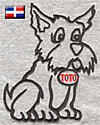The Jaragua National Park, located in the southwestern section of the country, is Dominican Republic's largest protected area, with 560 square miles. The park's name originated from the now-extinct Taino Indians that populated the area at the time of Columbus' arrival.
The park includes the Oviedo lagoon and the islands of Beata and Alto Velo. There is little rainfall in the area and the park has a desert like climate. Covered with a dry, thorn-forest there is a high population of cactus here.
Seventy-six species out of the 130 species of birds are known to exist in the Jaragua National Park, half of which live in an aquatic environment. The most common birds are the flamingos (largest population in the country), Great Egret, Little Blue Heron, Little Green Heron, Sooty Tern, Roseate Spoonbill and the White-crowned Pigeon. Other interesting species that live in the park include the ricord and rhinoceros iguanas, four types of marine turtles and 11 species of bats. The sea turtles climb up the park's beaches to lay their eggs.
Like many of the country's parks and scientific reserves, it has no tourist facilities and there are no guided tours available.









Bookmarks